
The scientific name of this plant is thyme or thyme, but even within the same country it is called differently. In Russia, in the Arkhangelsk, Kirov, Vologda regions, he is known as Bogorodskaya grass, in the middle lane as a chebark, pine forest pepper. Fragrant leaves of a miniature shrub are used in cooking as spices, in folk medicine they prepare infusions for various diseases. The genus of thyme numbers more than four hundred species and varieties, some of which grow in the wild, and some are cultivated by flower growers. New varieties of plants have been developed (see photo), which are distinguished by decorativeness and useful properties.
Content
- 1 Plant description
- 2 Varieties and types of thyme
- 2.1 Thyme Magenta
- 2.2 Mountain thyme
- 2.3 Chalk thyme
- 2.4 Rainbow thyme
- 2.5 Thyme Pygmy
- 2.6 Thyme bug
- 2.7 Thyme bush
- 2.8 Thyme Altai
- 2.9 Forest thyme
- 2.10 Beautiful thyme
- 2.11 Thyme Sommertime
- 2.12 Thyme Ural
- 2.13 Mossy thyme
- 2.14 Thyme Crimean
- 2.15 Thyme Talieva
- 2.16 Thyme early Minor
- 2.17 Thyme Red Carpet
- 2.18 Lemon Smelling
- 2.19 Donne Valley
- 2.20 Common Compactus
- 2.21 Thyme Creeping
- 2.22 Flea Thyme
- 2.23 Dorfler
- 2.24 Thyme Subarctic
- 3 Conclusion
Plant description
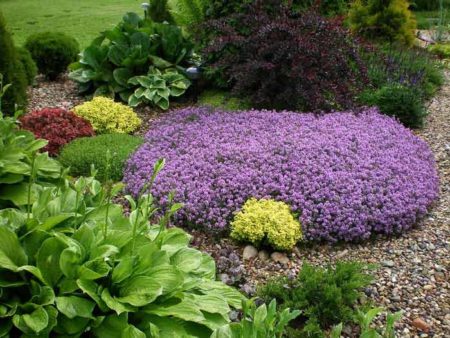
The name "thyme" is a derivative of the Greek word "incense", which means fragrant, fragrant substances. The plant belongs to the large family of Yasnotkovye, grows everywhere.
Outwardly, all plants are shrubs or shrubs, with a stalk height not exceeding 32-35 cm. The stems grow up, spread along the ground. Leaflets are small, round, oval, linear in shape. The surface is hard, leathery, leaf blades held on a stalk with short petioles. The bushes growing in the Far East have leaves with a jagged edge.
The inflorescences are elongated, capitate, flowers with a cylindrical calyx and a two-lipped nimbus. The color scheme is diverse, thyme grows in different regions with purple, pink, purple, whitish color. The main flowering period is summer, it starts to produce flowers from early June and blooms until early September. By autumn, fruit boxes with spherical nuts ripen.
The area of thyme growth is vast, whole clumps are found throughout Eurasia, in northern Africa. Common thyme prefers to grow on the edges of forests, on clearings, along highways. The plant is unpretentious, you can see it in the steppe and on chernozems, on rocky rocks and hills, among sandstones.
The leaves and stems of thyme contain essential oils that are useful for the human body amino acids. Medicinal decoctions, tinctures are prepared from dried grass, leaflets for aroma are added to tea.
Black thyme is an excellent honey plant that attracts bees and bumblebees to the sites. Indispensable low ground cover shrub in landscape design: for the arrangement of rock gardens, borders.
Varieties and types of thyme
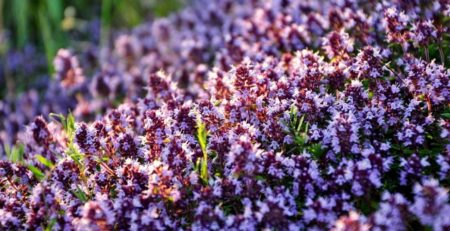
The genus Thyme includes a large number of species. Since 2002, specialists have created a new classification of the genus, where similar varieties are combined into sections.
Thyme Magenta
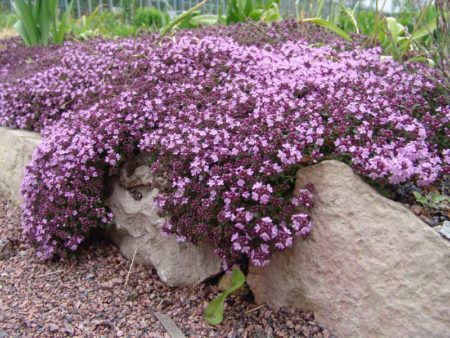
The beauty and unpretentiousness of this type of thyme was noted by landscape designers. The baby plant barely reaches 8-10 cm, grows quickly and covers large areas with a real green carpet.
At the moment of flowering of the Bogorodskaya grass, the carpet turns from green to lilac-purple. The sight is beautiful and attractive! The purple-violet thyme needs constant pruning, otherwise the bushes grow very much. In the absence of care, the grass suppresses other plants, flooding the entire area.
Mountain thyme
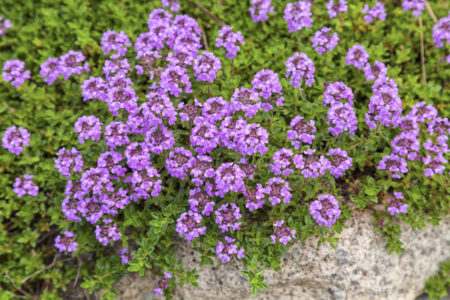
In the gorges of rocks, on stony slopes, a beautiful perennial with bright pink and purple flowers grows. A plant with short stems forming an extensive rosette. Height - no more than 15 cm.
The bushes are highly branched; during flowering, a characteristic spicy aroma is felt. Flowering begins in early June and continues until the fall. Thyme leaflets are an excellent seasoning for soups and meat dishes.
In gardens, it is often planted in rockeries.
Chalk thyme
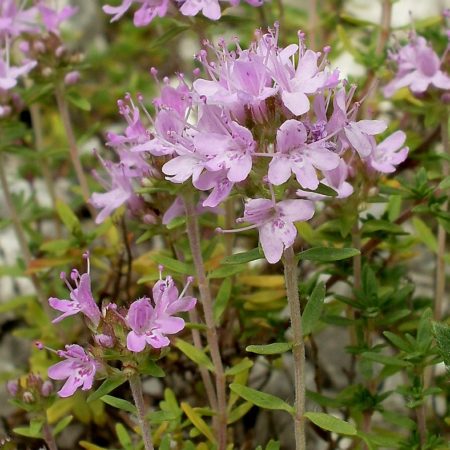
A unique representative of the genus, as it grows almost without soil. It is rare in nature, the main areas of growth are limestones. Hence the name of the grass - chalk. It blooms late, forming beautiful inflorescences of saturated pink color.
Plant height - 28-30 cm. Little leaflets, stalks bare. In the conditions of personal plots, they are planted near garden plantings, since the strong aroma of thyme flowers attracts a large number of bees.
Rainbow thyme
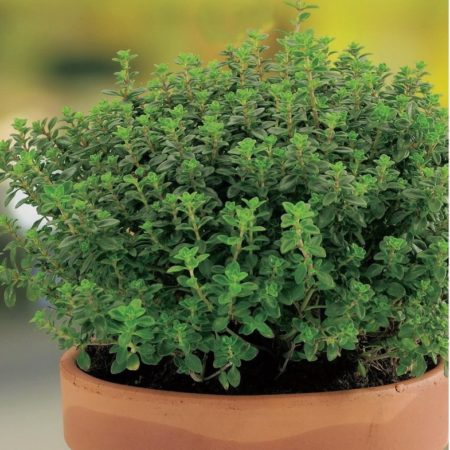
Fluffy shrub, 18-20 cm high. In the spring it gives very early greenery, used as a seasoning for dishes of vegetables and meat.
Creeping stems sprawl around. From germination to cutting, a little more than a month passes, and the leaves are ready for use in food. The second name is vegetable.
In areas grown as a perennial, but in winter, additional shelter is required. In regions with harsh winters, thyme bushes freeze out of mulch.
Thyme Pygmy
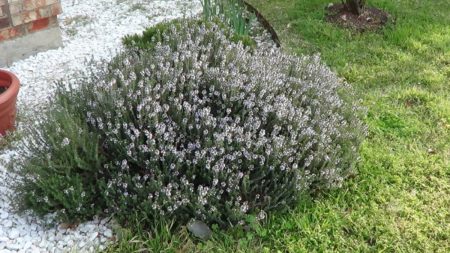
The variety got its name for dwarf growth. Thin shoots grow to a height of 4-5 cm in height, in dense herbs Pygmy almost invisible.
Tiny leaves of dark green color strew the stems. The plant winters well under snow, is cold resistant. The main flowering period is the end of May - mid-July. It is undemanding to soils, grows and gives color on poor, poorly cultivated soils. Pinkish-scarlet flowers form dense cones.
Thyme bug
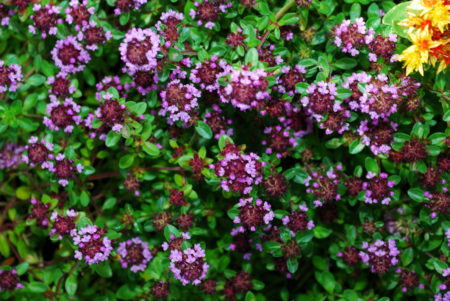
It grows in the southern Urals, is one of the plants listed in the Red Book. A rare plant forms a green veil with lilac flowers on the slopes and in the foothills.
The height of the shoots is 13-15 cm, the egg-shaped leaves are arranged in pairs. Flowering occurs from about mid-summer, lasts until September.
Thyme bush
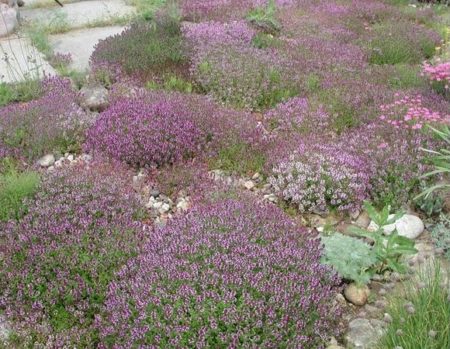
Among its unpretentious counterparts, bush thyme is notable for its soil fertility. On poor soils it gives weak rosettes, but on chernozem it forms a dark green dense crown.
Height - 20-25 cm, shoots grow up. There are few leaves, but everything is compensated by a large number of fragrant flowers. The color of the flowers is white, with a slightly pinkish glimpse. This form is recommended for cultivation as a houseplant. Also, thyme bush grows well in containers.
Thyme Altai
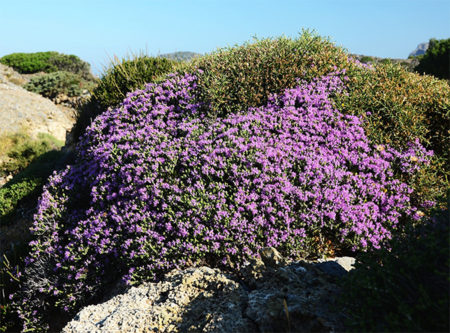
In Altai, the slopes of numerous mountains are covered with this unpretentious plant. The bushes form a grass cover, the height of the plants is 18-25 cm.
To soils, the species is undemanding, grows better in Cretaceous, calcareous territories. Drought-resistant, prefers to grow in areas well lit by the sun.
It begins to bloom early, from about the end of May until September. In addition to use in cooking, leaves and shoots are used for the manufacture of medicinal tinctures and decoctions. Valuable honey plant, highly decorative.
Forest thyme
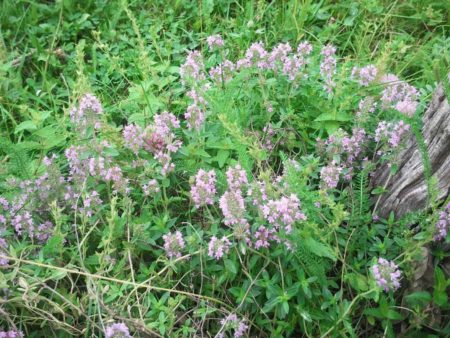
At the edges of the forest grows forest thyme - a low and unpretentious plant. The height reaches 18-20 cm, the flowers are lilac, small in size.The main peak of flowering occurs in mid-summer.
Very fragrant grass attracting pollinating insects. Honey collected from thyme has an original flavor bouquet, spicy aroma. Forest thyme grows well in the shade, but prefers light areas.
Beautiful thyme
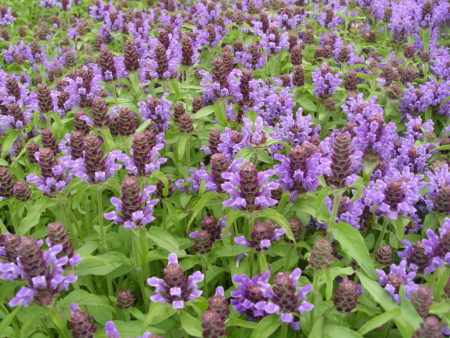
On the slopes of the Caucasus Mountains, in the steppe, a rare representative of the genus Thyme grows - beautiful. Bushes up to 25-30 cm high. Stalks with a large number of small leaves form a green cover. The color of leaf blades is green, petioles are short.
It forms inflorescences in the form of panicles, the flowers are purple, with a spicy aroma. By the end of July, fruit boxes with seeds ripen. The plant belongs to endangered species, protection is required.
Thyme Sommertime
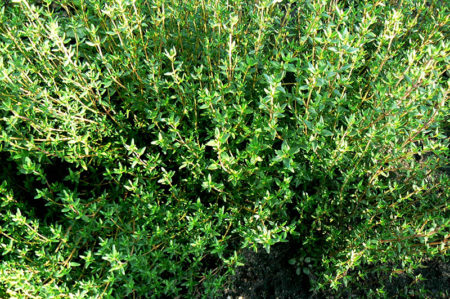
The variety is bred for cultivation as a pot culture. The plant is compact, with shoots raised up. It reaches a height of 20-25 cm.
The shoots are strewn with greenish-gray leaves. The shape of the plate is elongated, resembling long needles. The variety blooms from late spring to mid-summer, forms luxurious caps of lilac-colored inflorescences.
It is mainly grown as an annual, seedling technology is used. It does not tolerate a drop in temperature, when cultivated as a perennial plant, bushes are brought home for wintering.
The variety is used in folk medicine, cough broths are prepared from dried leaves and stems.
Thyme Ural
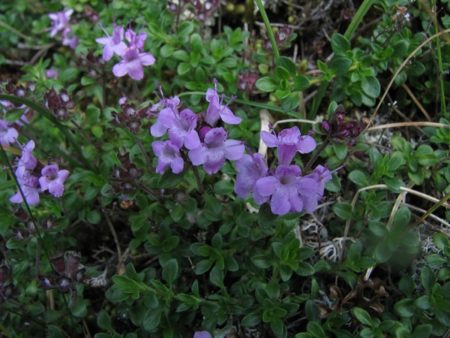
High enough, up to 30-35 cm, the plant chose the slopes of the mountains of the South Urals as its habitat. Unpretentious, growing on any soil, thyme needs a lot of sun. Often called it thyme Siberian. Prefers arid soils, well-lit areas. Even with light partial shade it does not give inflorescences, it is sick.
In open areas it blooms luxuriantly, covering the ground with a fluffy lilac-pink bedspread. The aroma of the Ural thyme is heard a few meters before the curtains.
Mossy thyme
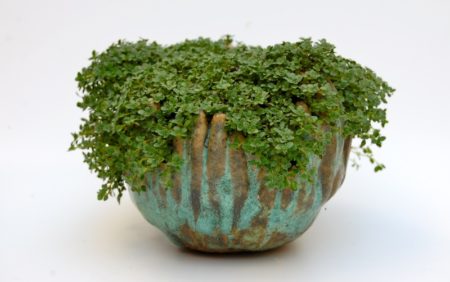
A kind of thyme grown for gardening. Feature: low height (2-3 cm), creeping stems. Ground cover plant with fine, dark green foliage.
The greens are thick, in appearance resembling moss (hence the name of the culture). Flowering is weak, mainly appreciate the plant for a dense hat of leaves. The color of the flowers is lilac.
Thyme Crimean
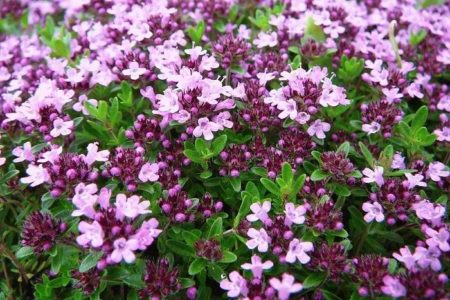
Sensitive to cooling, "southerner" grows in the valleys between the rocks and mountains of the Crimean peninsula. An unpretentious plant is characterized by good growth, a strongly branching stem, and a large number of green leaves.
It blooms only 30-40 days, by the beginning of July in the Crimea forming seed bolls. When growing on a site in the middle lane, shelter for the winter is required. In winters with little snow, it freezes.
Thyme Talieva
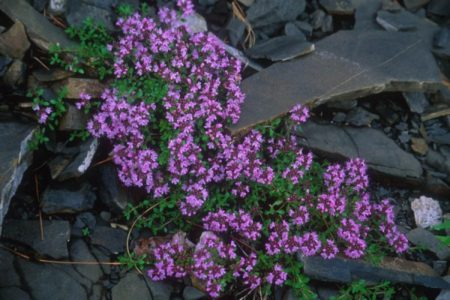
In Siberia, and in the regions of the European part of Russia, this variety of thyme is found. The name is given in honor of the scientist, professor of the Petrovsky Agricultural Academy Valery Ivanovich Taliev.
On sprawling, up to 13-15 cm tall bushes, rare long-leaflets are located. Inflorescences are collected in a panicle-shaped brush, the color is pink with violet spots. The view prefers rocky, rocky soils.
When used in the decorative design of plots, garden thyme is planted in alpine hills and rockeries. It blooms from half the summer until the beginning of autumn.
Thyme early Minor
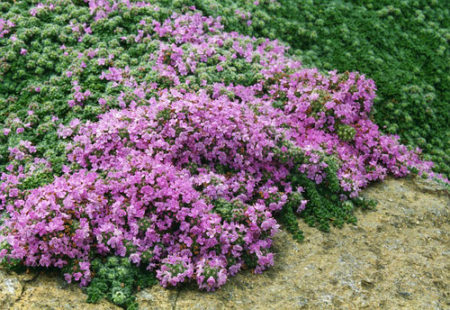
The peculiarity of this variety of thyme is an early set of colors and a long flowering period. Panicled, honey-inflorescences inflorescences are formed already in mid-June, capsules ripen by early fall.
The bushes of the ground cover type form a green carpet with a height of no more than 3-4 cm. Long inflorescences rise above the surface of the green bedspread, reaching 12-13 cm.Early Minor is a non-capricious, undemanding thyme variety. It grows slowly, tolerates prolonged droughts, does not need shelters for the winter period.
Thyme Red Carpet
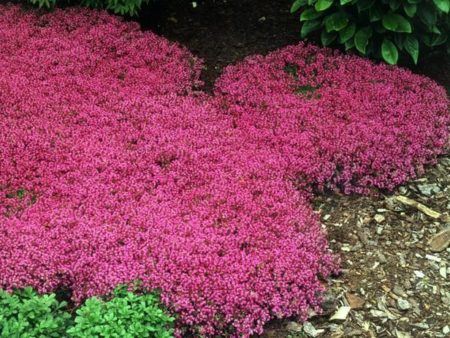
Beautiful undersized perennial with springy shoots and green foliage. It has a strong aroma. In landscape design, they are used to decorate bare areas in the garden.
The height of the plants does not exceed 6-7 cm. The leaves are triangular in shape, silver-green in color. The variety is characterized by rapid growth.
It forms numerous inflorescences with large purple and burgundy flowers.
The flowering period is the end of June - August. It is advisable to plant on sandy soils, this guarantees lush flowering throughout the summer period.
Lemon Smelling
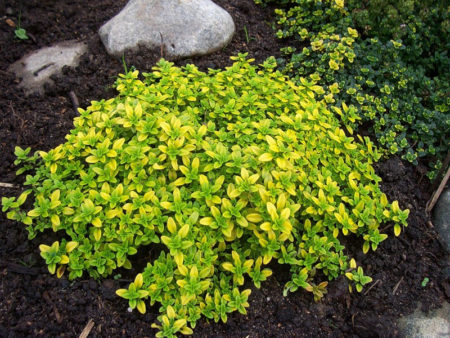
It belongs to hybrid forms, it is distinguished by beautiful leaves of motley coloring and lush flowering. Feature - rich citrus aroma of inflorescences.
The flowers are pale pink in color, while over the entire flowering period, the color changes from pale to saturated. The plant requires proper care: moderate watering, top dressing. It grows better on fertile soil, does not tolerate loam. Gives lush flowering in sunny areas.
Hybrids with different color leaflets were bred: Bertram Anderson (yellowish-green foliage), Golden Duarf (small green leaflets with bright yellow spots in the middle), Silver Quinn (green leaves with a silver border).
Among the popular species are thyme Donne Valley, with beautiful golden greens, as well as lemon-smelling thyme Archers Gold.
Donne Valley
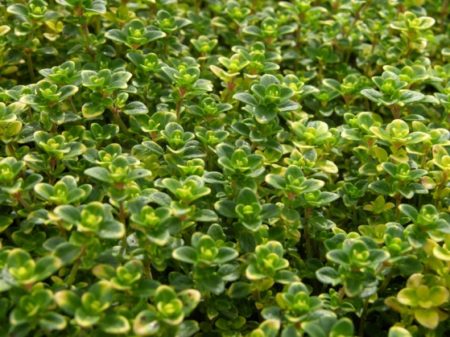
Reaches a height of almost 35 cm, forms multiple shoots of curved shape. Valued for decorative foliage - pale salad color with bright lemon and golden spots.
Paniculate inflorescences, purple in color. The hybrid is demanding on lighting, soil fertility. It does not tolerate waterlogging, suffers from subzero temperatures, so it must be covered for winter.
Used in landscaping, planted in rock gardens, like a border plant.
Common Compactus
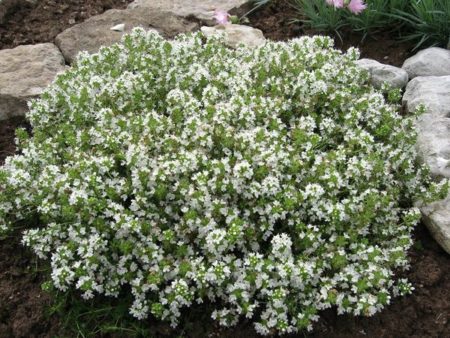
It is best suited for landscaping, as it is considered a capricious and unpretentious view. Plants reach a height of 18-20 cm, form a continuous green carpet.
Leaflets on the front side are smooth, from the bottom - slightly pubescent. The color gains in early summer, blooms continuously, almost all summer. Coloring - lilac, burgundy, pink, lilac, white. In addition to monocolour, varieties with bicolor flowers are bred.
Dried leaves and shoots are used as a spice, as a raw material for infusions and decoctions in folk medicine. Also extracts from this variety of thyme are components of various medications. The most popular varieties: Elfin (lilac inflorescences), snow-white Alba.
Thyme Creeping
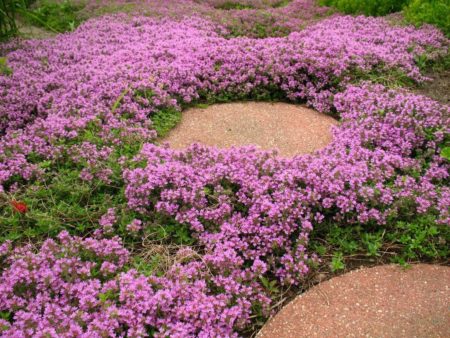
Combines several types of plants similar in stem structure. It features long, creeping shoots on the surface of the earth. The leaves are small, with a glossy surface, bright green in color. On the surface are glands containing essential oils.
Panicle inflorescences, color - white, pink, purple, burgundy, coral. Belongs to unpretentious species, grows on any soil, prefers light partial shade. Creeping thyme begins to produce flowers in the second half of summer.
Flea Thyme
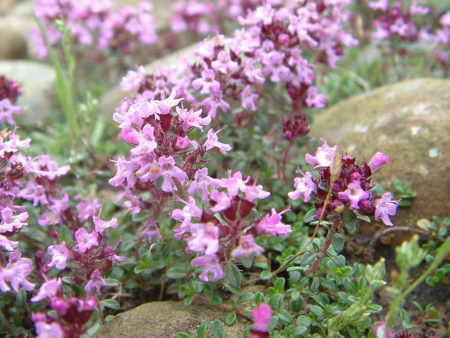
Lying bushes of this variety of thyme often grow near roads, on hills and mountain slopes. The bushes are dense, with a lot of glossy leaves. The plant reaches a height of 13-15 cm, forms peduncles in the form of panicles. The color of the flowers is pink, with lilac tints.
Appreciated this kind thyme for medicinal properties.
Dorfler
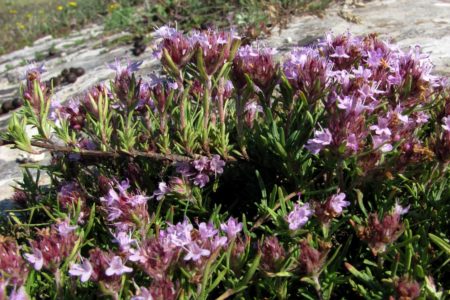
Mostly in the southern regions of Europe, Dorfler's thyme is found. The plant is capricious, loves warmth, a large amount of sun, therefore, is unsuitable for growing in the middle zone of the Russian Federation.
In the wild, grows on the Balkan Peninsula. Forms low bushes with heavily pubescent greenish leaves. Long flowering, small inflorescences, pale lilac in color.
Thyme Subarctic
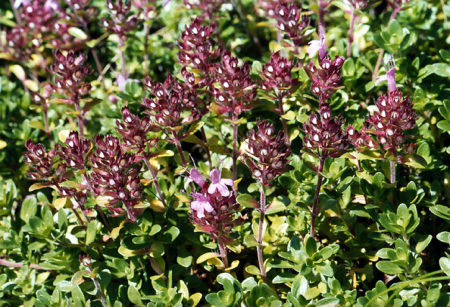
On the Kola Peninsula, in the countries of Scandinavia, thyme is found with numerous purple flowers. This is a subarctic species, characterized by endurance to low temperatures, little light.
Shoots grow up to 5-7 cm, leaflets with solid edges, bright green in color. Inflorescences are slightly pubescent, friable. The leaves, flowers and stems of the plant contain a large amount of essential oils.
Belongs to rare representatives of the genus, requires protection.
Conclusion
An interesting plant thyme (thyme) was loved by gardeners and flower growers. It is appreciated for its decorativeness, original aroma and taste of greenery, useful properties. Due to its unpretentiousness, thyme grows in various conditions, so it is easy to cultivate it in summer cottages or at home in pots.

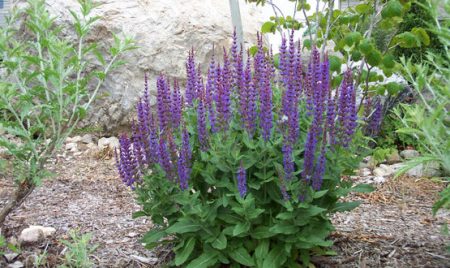
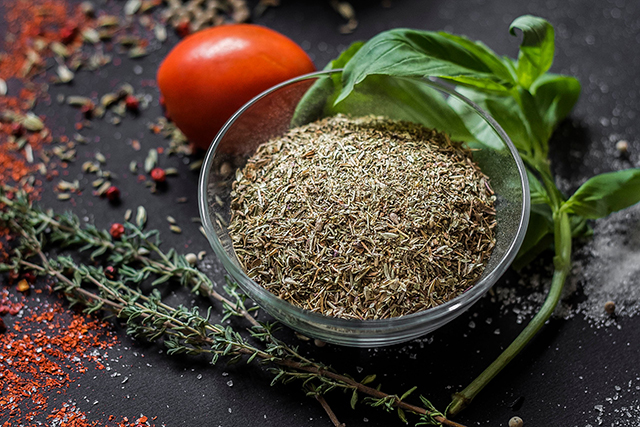
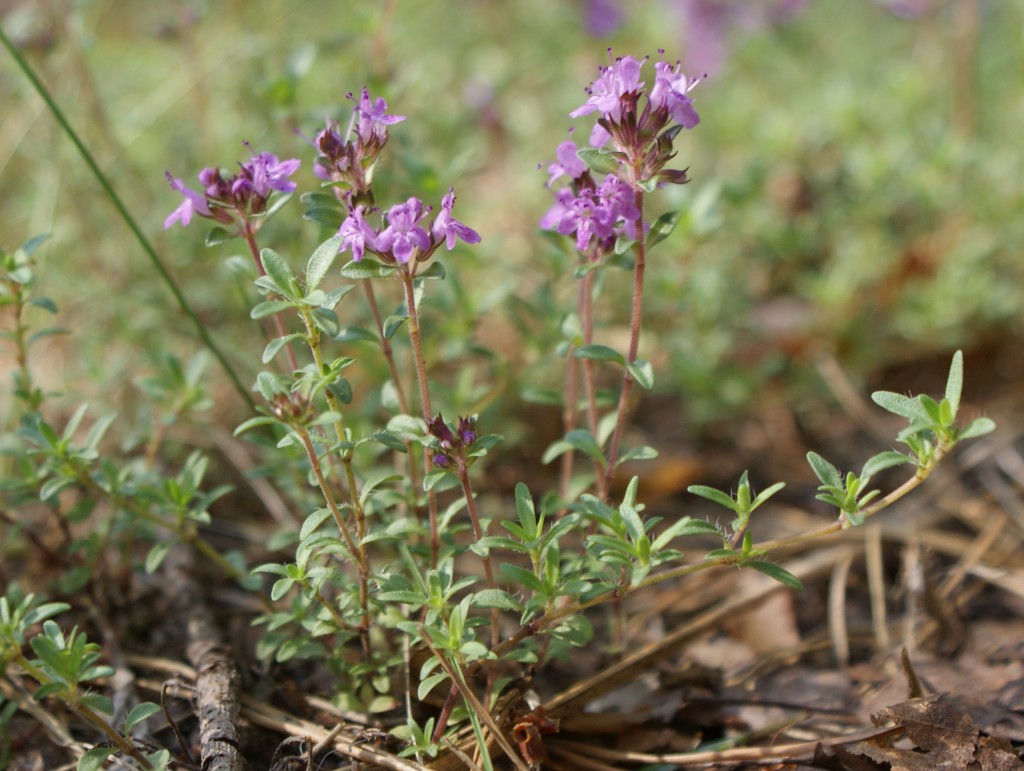 Creeping thyme: variety description, cultivation in open ground, planting and care
Creeping thyme: variety description, cultivation in open ground, planting and care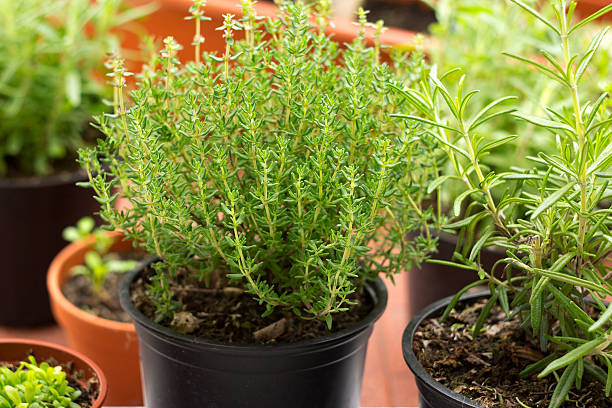 How to grow thyme from seeds at home on a windowsill in a pot
How to grow thyme from seeds at home on a windowsill in a pot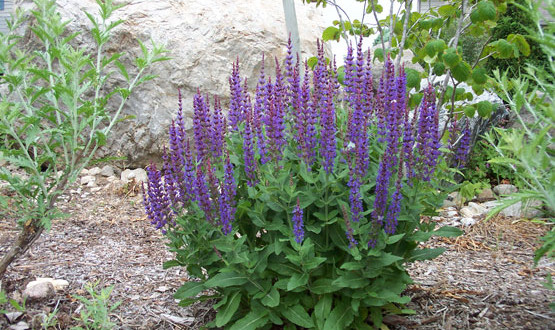 How to grow thyme in open ground near Moscow
How to grow thyme in open ground near Moscow